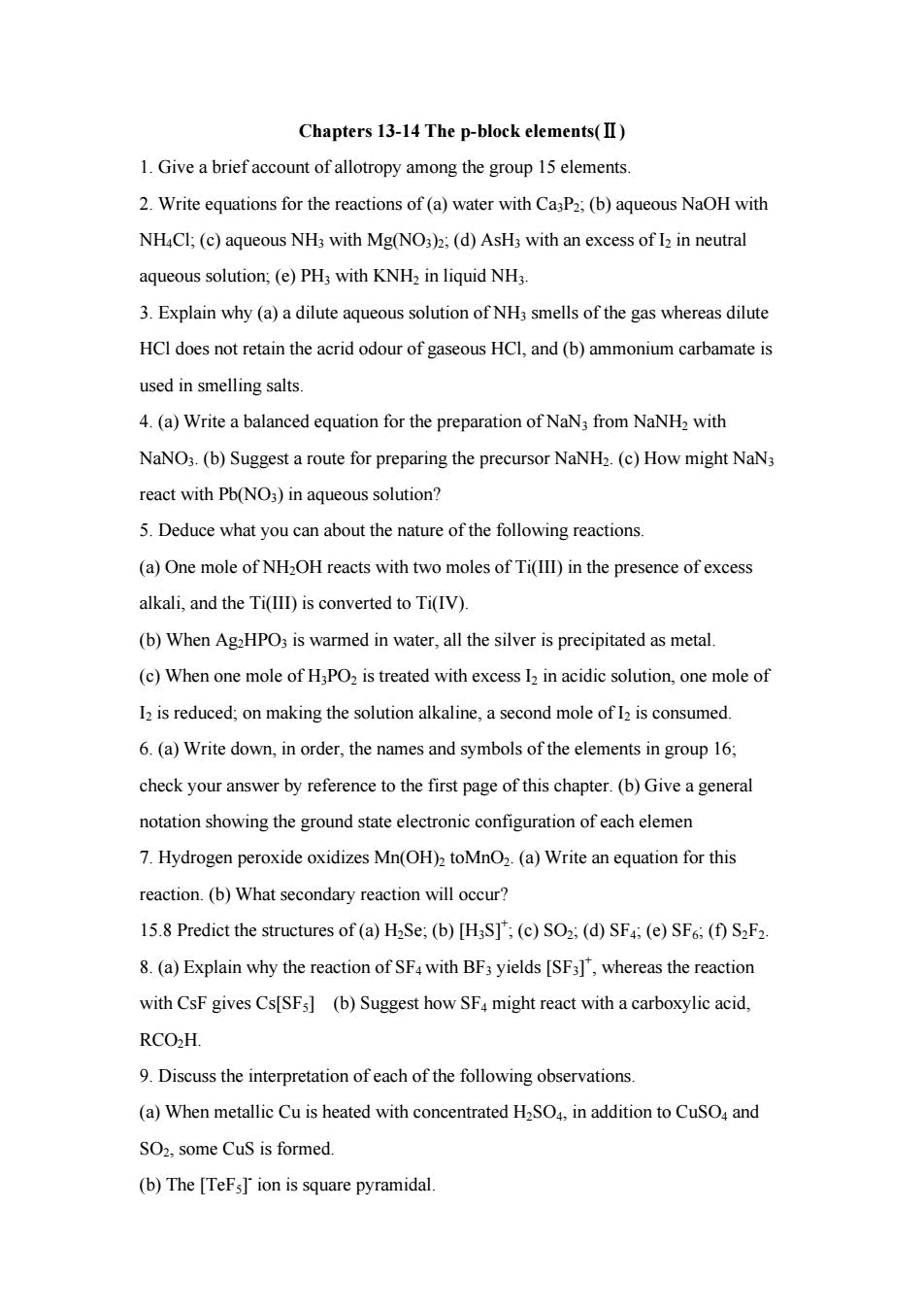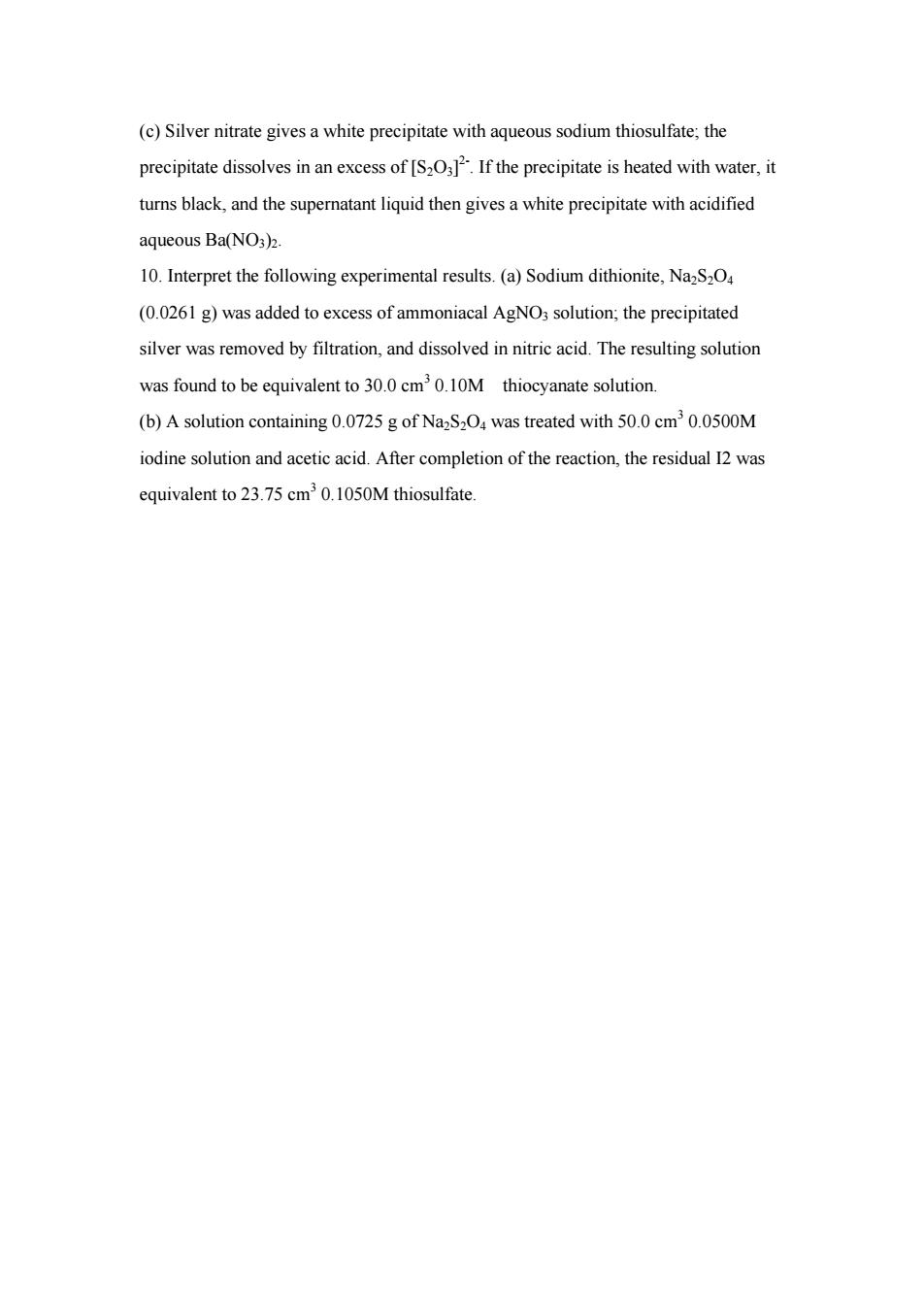
Chapters 13-14 The p-block elements(II) 1.Give a briefaccount of allotropy among the group 15 elements. 2.Write equations for the reactions of(a)water with CasP2,(b)aqueous NaOH with NHCl:(c)aqueous NH;with Mg(NO3)2:(d)AsH with an excess of I2 in neutral aqueous solution,(e)PH3 with KNH2 in liquid NH3. 3.Explain why (a)a dilute aqueous solution of NH,smells of the gas whereas dilute HCl does not retain the acrid odour of gaseous HCl,and(b)ammonium carbamate is used in smelling salts. 4.(a)Write a balanced equation for the preparation of NaN3 from NaNH2 with NaNO3.(b)Suggest a route for preparing the precursor NaNH2.(c)How might NaN3 react with Pb(NO3)in aqueous solution? 5.Deduce what you can about the nature of the following reactions. (a)One mole of NH2OH reacts with two moles of Ti(IIl)in the presence of excess alkali,and the Ti(III)is converted to Ti(IV). (b)When AgzHPO3 is warmed in water,all the silver is precipitated as metal (c)When one mole of HPO2 is treated with excess I2 in acidic solution,one mole of I2 is reduced;on making the solution alkaline,a second mole of I is consumed. 6.(a)Write down,in order,the names and symbols ofthe elements in group 16 check your answer by reference to the first page of this chapter.(b)Give a general notation showing the ground state electronic configuration of each elemen 7.Hydrogen peroxide oxidizes Mn(OH)toMnO.(a)Write an equation for this reaction.(b)What secondary reaction will occur? 15.8 Predict the structures of(a)H2Se.(b)[H3S]':(c)SOz:(d)SF.(e)SF.(f)SaF2. 8.(a)Explain why the reaction of SFwith BF3 yields [SF3,whereas the reaction with CsF gives Cs[SF (b)Suggest how SFmight react with a carboxylic acid, RCO2H. 9.Discuss the interpretation of each of the following observations. (a)When metallic Cu is heated with concentrated H2SO,in addition to CuSO and SO2,some Cus is formed (b)The [TeFsion is square pyramidal
Chapters 13-14 The p-block elements( ) Ⅱ 1. Give a brief account of allotropy among the group 15 elements. 2. Write equations for the reactions of (a) water with Ca3P2; (b) aqueous NaOH with NH4Cl; (c) aqueous NH3 with Mg(NO3)2; (d) AsH3 with an excess of I2 in neutral aqueous solution; (e) PH3 with KNH2 in liquid NH3. 3. Explain why (a) a dilute aqueous solution of NH3 smells of the gas whereas dilute HCl does not retain the acrid odour of gaseous HCl, and (b) ammonium carbamate is used in smelling salts. 4. (a) Write a balanced equation for the preparation of NaN3 from NaNH2 with NaNO3. (b) Suggest a route for preparing the precursor NaNH2. (c) How might NaN3 react with Pb(NO3) in aqueous solution? 5. Deduce what you can about the nature of the following reactions. (a) One mole of NH2OH reacts with two moles of Ti(III) in the presence of excess alkali, and the Ti(III) is converted to Ti(IV). (b) When Ag2HPO3 is warmed in water, all the silver is precipitated as metal. (c) When one mole of H3PO2 is treated with excess I2 in acidic solution, one mole of I2 is reduced; on making the solution alkaline, a second mole of I2 is consumed. 6. (a) Write down, in order, the names and symbols of the elements in group 16; check your answer by reference to the first page of this chapter. (b) Give a general notation showing the ground state electronic configuration of each elemen 7. Hydrogen peroxide oxidizes Mn(OH)2 toMnO2. (a) Write an equation for this reaction. (b) What secondary reaction will occur? 15.8 Predict the structures of (a) H2Se; (b) [H3S]+ ; (c) SO2; (d) SF4; (e) SF6; (f) S2F2. 8. (a) Explain why the reaction of SF4 with BF3 yields [SF3] + , whereas the reaction with CsF gives Cs[SF5] (b) Suggest how SF4 might react with a carboxylic acid, RCO2H. 9. Discuss the interpretation of each of the following observations. (a) When metallic Cu is heated with concentrated H2SO4, in addition to CuSO4 and SO2, some CuS is formed. (b) The [TeF5] - ion is square pyramidal

(c)Silver nitrate gives a white precipitate with aqueous sodium thiosulfate;the precipitate dissolves in an excess of [OIf the precipitate is heated with water,it tums black,and the superatant liquid then givesa white precipitate with acidified aqueous Ba(NO3)2. 10.Interpret the following experimental results.(a)Sodium dithionite,Na (0.0261 g)was added to excess of ammoniacal AgNO;solution;the precipitated silver was removed by filtration,and dissolved in nitric acid.The resulting solution was found to be equivalent to 30.0cm0.10M thiocyanate solution (b)A solution containing 0.0725g of Na2S2O was treated with 50.0cm0.0500M iodine solution and acetic acid.After completion of the reaction,the residual 12 was equivalent to 23.75 cm0.1050M thiosulfate
(c) Silver nitrate gives a white precipitate with aqueous sodium thiosulfate; the precipitate dissolves in an excess of [S2O3] 2-. If the precipitate is heated with water, it turns black, and the supernatant liquid then gives a white precipitate with acidified aqueous Ba(NO3)2. 10. Interpret the following experimental results. (a) Sodium dithionite, Na2S2O4 (0.0261 g) was added to excess of ammoniacal AgNO3 solution; the precipitated silver was removed by filtration, and dissolved in nitric acid. The resulting solution was found to be equivalent to 30.0 cm3 0.10M thiocyanate solution. (b) A solution containing 0.0725 g of Na2S2O4 was treated with 50.0 cm3 0.0500M iodine solution and acetic acid. After completion of the reaction, the residual I2 was equivalent to 23.75 cm3 0.1050M thiosulfate